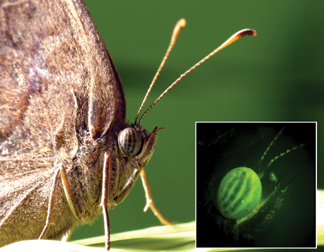New Green Eyes: First butterfly that's genetically modified
Susan Milius
Scientists
have for the first time genetically engineered a butterfly, inserting a
jellyfish gene into an African butterfly so that its eyes fluoresce
green.  | EYE FOR EYES. The natural form of an African tropical butterfly Bicyclus anynana. Inset: The magnified eye of a genetically engineered butterfly glows green.
W. Piel; (inset) Ramos |
The butterfly, Bicyclus anynana,
serves as an important subject for studies of how genes control
development and how those controls evolve, says Antónia Monteiro of
State University of New York (SUNY) at Buffalo. She and her colleagues
figured out how to use molecular techniques to transform the butterfly
and open new research opportunities in genetics, she says. The
researchers describe their work in an upcoming issue of the Royal
Society of London's Biology Letters.
"I think the transformation is a very important tool," comments
Daniel Bopp of the Zoological Institute of the University of Zurich,
whose team in 2001 made the first genetically modified housefly. "It's
a very targeted way to try to understand the function of a gene," he
says.
It's been more than 20 years since researchers first
genetically engineered an insect, the laboratory fruit fly. In the past
decade, the pace has picked up, and biologists have worked out how to
manipulate a wide variety of other insects, including several
mosquitoes, screwworms, and two moths—the silkworm and the pink
bollworm.
To get genes into a new organism, researchers depend on bits of
DNA called transposons, which naturally infiltrate a host's genes.
Monteiro, working with Jeffrey M. Marcus of Western Kentucky University
in Bowling Green and Diane Ramos of SUNY Buffalo, ferried the jellyfish
gene in modified forms of the transposons Hermes, which was originally from a housefly, and piggyBac, from a cabbage looper moth.
The researchers chose the jellyfish gene for a green fluorescent
protein that other researchers had used to create glowing green eyes in
houseflies and some other insects.
The team injected the gene and a modified transposon into each
of more than 10,000 butterfly eggs. About 95 percent of the eggs died.
Of the survivors, 5 percent getting piggyBac and 10 percent getting Hermes transposons passed along green-fluorescing eyes to their offspring.
Monteiro plans to use this technique to study genes suspected of
creating spots on butterfly wings (SN: 2/15/03, p. 104: Available to
subscribers at http://www.sciencenews.org/articles/20030215/bob9.asp).
Previous research has shown that similar genes in fruit flies control
top-bottom orientation, leg development, and other developmental
milestones. Monteiro will, for example, add extra copies of one of
these genes and turn it on in unusual places. Ultimately, she says she
wants to know, "How is it that the same old genes acquire these totally
novel functions in butterfly wings?"
| If you have a comment on this article that you would like considered for publication in Science News, send it to editors@sciencenews.org. Please include your name and location.
|
To subscribe to Science News (print), go to https://www.kable.com/pub/scnw/ subServices.asp.
To sign up for the free weekly e-LETTER from Science News, go to http://www.sciencenews.org/pages/subscribe_form.asp.

References: Marcus, J.M., D.M. Ramos, and A. Monteiro. In press. Germline transformation of the butterfly Bicyclus anynana. Proceedings of the Royal Society of London B: Biology Letters. Abstract available at http://www.journals.royalsoc.ac.uk/openurl.asp?
genre=article&id=doi:10.1098/rsbl.2004.0175 .
Further Readings: Milius, S. 2003. How the butterfly gets its spots. Science News 163(Feb. 15):104-106. Available to subscribers at http://www.sciencenews.org/articles/20030215/bob9.asp.
For pictures of the butterfly and more on eyespot research, go to http://www.acsu.buffalo.edu/~monteiro/index.html.
For movies of insect development, go to http://www.molbio.wisc.edu/carroll/movies.html.
Sources: Daniel Bopp
Zoological Institute
University of Zürich
Winterthurerstrasse 190
CH-8057 Zürich
Switzerland
Jeffrey Marcus
Department of Biology
Western Kentucky University
Bowling Green, KY 42101
Antónia Monteiro
Department of Biological Sciences
State University of New York, Buffalo
Buffalo, NY 14260
Diane Ramos
Department of Biological Sciences
State University of New York, Buffalo
Buffalo, NY 14260
|